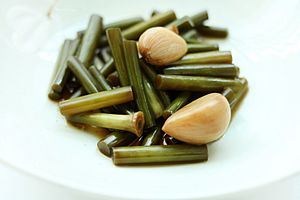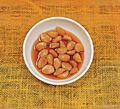Jangajji facts for kids

maneul-jong-jangajji (pickled garlic scapes and cloves)
|
|
| Alternative names | Pickled vegetables |
|---|---|
| Type | Pickles |
| Course | Banchan |
| Place of origin | Korea |
| Associated national cuisine | Korean cuisine |
| Korean name | |
| Hangul |
장아찌
|
|---|---|
| Revised Romanization | jangajji |
| McCune–Reischauer | changatchi |
| IPA | [tɕaŋ.a.t͈ɕi] |
Jangajji (장아찌) is a yummy Korean side dish. It's also known as pickled vegetables. People make jangajji by pickling different vegetables.
Unlike kimchi, which is fermented, jangajji is made from vegetables that are not fermented. They are usually pickled in special sauces like soy sauce, soybean paste, or chili paste. Jangajji can be kept for a very long time. It's often served with a little bit of sesame oil drizzled on top.
Koreans developed preserved foods like jangajji a long time ago. This helped them eat enough vegetables during the cold, harsh winters on the Korean peninsula.
What is Jangajji?
Jangajji is a type of banchan, which means it's a side dish served with a main meal in Korea. It's a great way to enjoy vegetables all year round.
Ingredients for Jangajji
The vegetables used for jangajji can change depending on the region and the season. Some popular choices include green garlic, garlic scapes (the curly stems of garlic plants), radish, cucumber, chili pepper leaves, and perilla leaves.
The main liquids used for pickling are soy sauce, soybean paste, or chili paste. Sometimes, people also use salty water (called brine) or watered-down vinegar.
Before pickling, vegetables are often slightly dried or salted. This helps remove extra water, which keeps the jangajji fresh for longer. When it's time to eat, jangajji is usually cut into pieces. Then, it's seasoned with sesame oil, a little sugar, and toasted sesame seeds. This makes it taste even better!
Types of Jangajji
There are many different kinds of jangajji, each made with a unique vegetable. Here are some examples:
- boksa-jangajji (복사장아찌) – pickled peach
- buchu-jangajji (부추장아찌) – pickled garlic chives
- chamoe-jangajji (참외장아찌) – pickled Korean melon
- cheoncho-jangajji (천초장아찌) – pickled chopi fruits
- doraji-jangajji (도라지장아찌) – pickled balloon flower roots
- gaji-jangajji (가지장아찌) – pickled eggplants
- kkaennip-jangajji (깻잎장아찌) – pickled perilla leaves
- maneul-jong-jangajji (마늘장아찌) – pickled garlic, both garlic scapes and cloves
- meowi-jangajji (머위장아찌) – pickled butterbur leaves
- mu-jangajji (무장아찌) – pickled Korean radish
- mu-mallaengi-jangajji (무말랭이장아찌) – pickled dried radish
- oi-jangajji (오이장아찌) – pickled cucumber
- pa-jangajji (파장아찌) – pickled scallions
- put-gochu-jangajji (풋고추장아찌) – pickled green chili peppers
- put-maneul-jangajji (풋마늘장ajji) – pickled green garlic
- saenggang-jangajji (생강장아찌) – pickled ginger
- sancho-jangajji (산초장아찌) – pickled prickly ash fruits
- umu-jangajji (우무장아찌) – pickled agar jelly
- yeolmu-jangajji (열무장아찌) – pickled young summer radish
Gallery
-
Bom-namul-jangajji (pickled spring herbs)
-
Gochu-jangajji (pickled chili peppers)
-
Kkaennip-jangajji (pickled perilla leaves)
-
Kkwari-gochu-jangajji (pickled groundcherry peppers)
-
Maneul-jangajji (pickled garlic)
-
Maesil-jangajji (pickled plums)
-
Mu-jangajji (pickled radish)
-
Myeongi-jangajji (pickled Siberian onion leaves)
-
Chamoe-jangajji (pickled chamoe, Korean melon)
See also
In Spanish: Jangajji para niños











